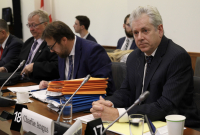Support strong Canadian climate journalism for 2025
For Lisa Hayhurst, heating and cooling her home is a constant shuffle. Poor insulation and cracks in her floorboards allow energy to snake out, causing her power bill to skyrocket. She cranks the heat for short periods in the winter, doing her best to keep her rental at a livable temperature.
Hayhurst, who is chair of her local ACORN chapter, lives in Nova Scotia, the province with the highest rate of energy poverty, which is often defined as the point when people struggle to meet their homes’ energy needs. In some cases, it means not being able to pay other household bills or not having the means to adequately heat or cool homes. Last week, a report released by the Nova Scotia Energy Poverty Task Force recommended solutions for the province’s “energy poverty crisis.” The force was established in 2022 and includes multiple groups, such as the Ecology Action Centre and the province’s department of Natural Resources and Renewables.
The report, titled A Way Forward: A Made-in-Nova Scotia Home Energy Affordability Program, says a four-part solution would help a significant portion of the 43 per cent of Nova Scotians who have difficulties affording their energy bills:
- Apply energy bill discounts to people with low incomes
- Design a debt forgiveness program for power bills
- Create a crisis intervention fund that could help people pay their bills on a limited-time basis
- Expand energy efficiency and electrification supports for low- and moderate-income households
“In 40 years of experience in over 40 jurisdictions across North America, I’ve never seen an energy affordability situation as bad as Nova Scotia is in right now,” said Robert Colton, report author and utility affordability expert.
“Consistently low incomes and volatile spikes in home heating fuels have laid the groundwork for this crisis, but thankfully, there’s a way out.”
The province has the highest percentage of households — at 36 per cent — relying on fuel oil: the most expensive way to heat a home.
Ontario
Other provinces also experience challenges with energy poverty, including Ontario, which the report pointed to as a province with a bill discount program. It notes the program provided energy relief to 212,000 low-income households in 2023. Depending on the household size, monthly credits of $35 to $113 are available to people, with the higher-end applying to Indigenous customers, people using electricity-intensive medical devices and others.
The program has made a difference in the province, explains Jacqueline Wilson of the Canadian Environmental Law Association. While Ontario doesn’t have as high a percentage of people experiencing energy poverty as Nova Scotia, it has the highest overall numbers at 1.1 million households.
The program is “something that we do have in Ontario that's really strong,” and that is “needed in Nova Scotia to make things more affordable,” explained Wilson.
In Ontario, there are a total of 5.25 million electrical customers (which includes residential and small businesses), 450,000 of which rely on electrical heating. Meanwhile, 3.7 million people rely on natural gas. The bill discount program only applies to electricity users and Wilson said the program should be expanded to include households with other types of heating.
At the same time, government funding is needed to transition people off fossil fuels to reduce emissions and bills, said Wilson. However, Ontario Premier Doug Ford has passed legislation to support Enbridge in locking in gas customers for decades.
Ontario has a heat pump program for low-income households. In P.E.I., free heat pumps are available to people with an annual household net income of $75,000 or less; Nova Scotia has similar funding. All provinces and territories, except Alberta, have at least one energy efficiency program in place, though not all include heat pumps and vary in how much they help low-income households.
To Brian Gifford, chair of the Energy Poverty Task Force and the Affordable Energy Coalition, Nova Scotia implementing the measures “is just common sense.” He points to a recent survey by the province’s utility, which found that about three out of four homes experiencing energy poverty delayed paying for necessities such as groceries or medication to pay their bill.
“These are impossible decisions that nobody should have to make,” says Gifford.
“Everyone should be able to access energy without having to go without other basic needs. The recommendations in this report show us a way to get there.”
The federal government’s new Canada Greener Homes Affordability program will hopefully support some of the deep retrofits needed to lower energy bills across Canada, while bill support measures should be available to assist those currently experiencing energy poverty, explained Wilson.
Unlike its predecessor, the Canada Greener Homes Grant, the new program will target low and medium-income households. Details have yet to be announced, but Wilson hopes the federal measures will help fill gaps left by provincial programs. The benefits would be widespread across the country: recent research from McGill University found that one in five Canadians experience energy poverty.
In a statement to Canada’s National Observer, the province of Nova Scotia said it will “review” the report, and has already committed to “look at” Ontario’s model for bill discounts. The statement pointed to the Heating Assistance Rebate program, which gave over 100,000 people about $77 million in rebates in 2023, among other initiatives already underway to address energy poverty.
This article was updated to correct the number of people in Ontario who use electric heat.





Comments
Just to highlight a few considerations that come to mind:
1. Energy poverty as defined does not differentiate between actual energy consumption between households; I think it needs to. For example, someone may earn $2000/month after taxes but spend $400/mo heating their paper shack (leaving $1600 for other expenses). Another person may have net income of only $1000 but have a very comfy abode needing only $50/month to heat (leaving $950 for other expenses). Having said that, the report does address the broader idea in “Outcome measured”, on p.92.
2. There was no discussion of the impact of having private, rather than publicly owned energy suppliers. Public ownership means that the utility has the potential to serve the long-term public good as an integral pillar of public policy with an aim to reduce energy consumption. What private supplier looks to either reduce consumption or be a willing partner is public policy that is other than self-serving?
3. There was no discussion of bill charges unrelated to consumption, such as “grid access” or, in the case of NSPOWER, a “Base Charge”. ** In Ontario, there are “Distribution charges”, “Customer Service Charges”, “Transmission Charges”, “Line Loss Adjustments”*** which include both consumption and non-consumption-related amounts. How many gas stations charge a flat-rate “pump access” fee when one fills up? The problem with non-consumption-related charges is that, at the margin, it can dissuade consumers from actively taking measures to reduce their consumption (why bother, if they always have to pay something even if they consume absolutely nothing).
4. Although it's looking in the review mirror, I am very interested to learn why methane never made serious inroads into the maritime provinces. Anyone? There’s an obvious corporate address at which to start a search for a reason that petroleum still apparently reigns supreme in home heating down east, and it would be useful to either confirm or refute that possibility.
5. Programs to financially support retrofits are needed and it’s good to see they have been implemented and are useful. However, a search in the report didn’t return any mention of building codes; that is, what steps have been/ will be immediately implemented to upgrade building standards vis-à-vis energy needs such that the liability of future energy poverty is not increasing with each new residence built today?
6. Who makes the call when determining that a structure is not worth retrofitting? I expect there are some houses which are simply not cost-effective to retrofit and to do so would be a complete waste of money. Hopefully this is a very small number of residences.
** https://www.nspower.ca/your-home/create-manage-account/billing-payments…
*** https://www.oeb.ca/consumer-information-and-protection/electricity-rate…
Exemplary comments. Thankyou.
The public vs private utility observation is especially relevant. On the opposite coast we have a most stark comparison between BC Hydro and the array of private power companies next door in Alberta.
BCH is a huge public utility that has developed the province's renewable (with caveats) hydroelectricity infrastructure and is subject to government control. Rates are affirdable at the base step level. Alberta's power comes mainly from private gas and coal-fired power plants.
Since Danielle Smith was elected with her political trajectory fired up in part by private power company donors, their wind and solar competitors have been eliminated and the resulting oligopoly was allowed to jack up power rates by orders of magnitude for no explicable reason other than they can.
Prior to that, renewable energy companies were mopping the floor with gas and coal power on price, giving Alberta consumers a break.
It's unfortunate that Smith knifed the infant 35 billion dollar wind and solar industry in the back before they could build out adequate grid-scale battery storage. Public or private, the most recent jurisdictions where batteries were installed at massive scales (Australia + California), gas and coal power companies are now being overrun and are rightly fearful for their survival. This evolution is happening in months, not years.
The fact is that fossil power companies going down does not generate public sympathy, except with their employees, owners and shareholders. But then thousands of new jobs are being created in renewables, easing the pressures of transitioning.
In the hands if public utilities with government oversight, it seems perfectly rational that diversifying into wind, solar and geothermal backed by mass battery storage will ensure the future is brighter and more affordable than private power, especially when private companies are depend
...dent on fossil fuels.
[Apologies-no Edit button supplied]
50 million would provide a heat pump for the majority of NS homes, especially those financially strained.